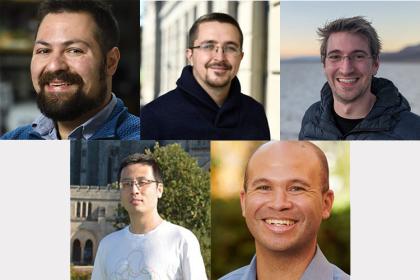Stephen Fried, Benjamin Grimmer, Justus Kebschull, Jonathan Lynch, and Yahui Zhang recognized for their potential to become leaders in their respective fields
By Aleyna Rentz
Five Johns Hopkins faculty members have been named 2024 Sloan Research Fellows, a prestigious award celebrating rising stars in academia. In all, 126 early-career scholars were recognized this year.
Awarded annually since 1955 by the Alfred P. Sloan Foundation, the fellowship honors exceptional U.S. and Canadian researchers whose creativity, innovation, and research accomplishments make them stand out as the next generation of leaders. Open to scholars in seven fields—chemistry, computer science, Earth system science, economics, mathematics, neuroscience, and physics—the Sloan Research Fellowships are awarded in close coordination with the scientific community. To date, fellows have gone on to win 57 Nobel Prizes and 71 National Medals of Science.

Image caption:The 2024 Sloan Research Fellows from Johns Hopkins are (clockwise from top left) Stephen Fried, Benjamin Grimmer, Justus Kebschull, Jonathan Lynch, and Yahui Zhang
Candidates must be nominated by their fellow scientists and winners are selected by independent panels of senior scholars based on a candidate’s research accomplishments, creativity, and potential to become a leader in their field. More than 1,000 researchers are nominated each year. Winners receive a two-year, $75,000 fellowship which can be used flexibly to advance the fellow’s research.
Including this year’s winners, 87 faculty from Johns Hopkins University have received a Sloan Research Fellowship.
The five newest Sloan recipients from Johns Hopkins University are:
Stephen Fried
Assistant professor, departments of Chemistry and Biophysics
Artificial intelligence is surprisingly good at folding proteins into their correct 3-D structures, and yet proteins themselves are surprisingly not good at this task—oftentimes they are prone to “misfold” or stick together, which causes them to lose their functions and make cells sick. These processes are at the root of most neurodegenerative diseases such as Alzheimer’s and may also be a factor in aging more broadly. Stephen Fried‘s research pioneered the use of mass spectrometry proteomics to interrogate protein folding on the scale of entire proteomes. These studies have provided an array of insights on questions as diverse as the molecular basis of aging, the origins of life, and the function of disorder in the yeast proteome.
Benjamin Grimmer
Assistant professor, Department of Applied Mathematics and Statistics
Benjamin Grimmer has recently become fascinated with computer-aided optimization of the algorithms used to solve big real-world problems. A new wave of results in his field (optimization) has made computers provably good at this. Many of our now strongest algorithmic guarantees have only been made possible thanks to computer-assistance. Grimmer’s research also recently had breakthrough results, covered by Quanta Magazine, showing that a new computer-aided analysis approach can beat the well-established textbook theory for gradient descent.
Justus M. Kebschull
Assistant professor, Department of Biomedical Engineering
Justus Kebschull‘s research aims to understand the structure and function of the brain. To do so, he takes a comparative approach and engineers molecular, viral, and sequencing technologies to measure neuronal connectivity networks and gene expression at scale in disease models and a wide range of vertebrates. He developed the first barcode sequencing-based approaches to map neuronal connectivity, increasing throughput of single-neuron mapping by orders of magnitude and opening the door to single-cell comparative connectomics. He complements these barcoding approaches by in situ sequencing of barcodes and genes. Leveraging these technologies, his team asks questions including: How do new brain regions and connections evolve to support new computations? What are the organizing principles and fundamental circuit motifs of the vertebrate brain? And how do drugs of abuse and neurodevelopmental disorders break these principles? His work is highly interdisciplinary, residing at the interface of molecular engineering, neuroscience, synthetic and evolutionary biology, genomics, virology, and computational biology.
Jonathan Lynch
Assistant professor, Biochemistry, Cellular, and Molecular Biology Graduate Program
Animals, including humans, have stable relationships with communities of microorganisms collectively referred to as the microbiota. These communities profoundly influence the biology of their hosts, impacting host features such as immune function, metabolism, and even so-called “higher” traits such as cognition and social behavior. Due to the wide range of microbiota-associated effects on host biology, understanding host-microbe relationships is not only important for understanding the normal physiology of the host, but may also allow us to use the microbiota to intentionally shape host health. Jonathan Lynch focuses on several areas of host-microbe symbiosis, ranging from the fundamental features that govern these relationships to the translational prospects of using the microbiota to improve human health. This includes roles of intestinal bacteria in shaping host lipid and cholesterol metabolism, interactions between the microbiota and neurotransmitters, and the biophysical drivers of microbial colonization. He employs diverse techniques from molecular biology, biochemistry, and a variety of -omics platforms to explore our interactions with our microbial partners.
Yahui Zhang
Assistant professor, Department of Physics & Astronomy
Yahui Zhang works on theoretical condensed matter physics, which studies quantum materials with novel emergent properties due to the collective motion of many electrons. The current focus is in the following two directions: exploring new platforms for high temperature superconductor, for example, in bilayer nickelate material and in multilayer optical lattice; and engineering exotic fractional phases of matter in moire superlattices formed by twisting two sheets of two dimensional materials such as graphene.